EYFS Framework: Assessment, Record Keeping, and Implementation
VerifiedAdded on 2023/06/07
|6
|1186
|235
Report
AI Summary
This report provides a detailed overview of the Early Years Foundation Stage (EYFS) framework, focusing on assessment and record-keeping practices. It explains the structure of the EYFS, including the seven areas of learning and development that shape educational programs for young children. The report differentiates between formative and summative assessment, highlighting their positive and negative attributes, and identifies key individuals who should be informed about a child's progress. Furthermore, it discusses the roles and responsibilities of key personnel in planning and implementing the next stages of learning and outlines the methods for maintaining records of observation and assessment within an organization, including the legal requirements for record-keeping in the early education system. The document emphasizes the importance of these practices in supporting child development and ensuring effective learning environments.
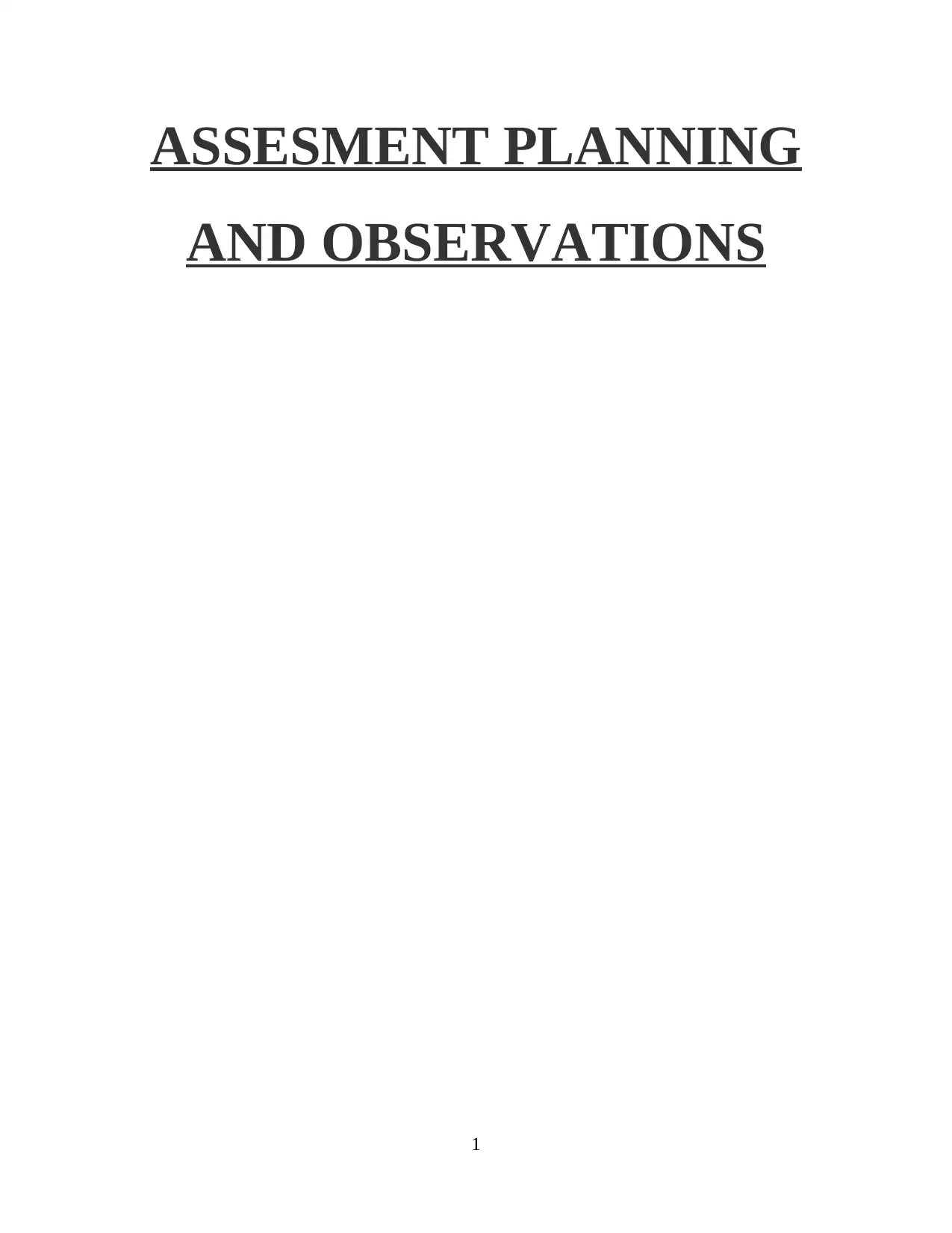
ASSESMENT PLANNING
AND OBSERVATIONS
1
AND OBSERVATIONS
1
Paraphrase This Document
Need a fresh take? Get an instant paraphrase of this document with our AI Paraphraser
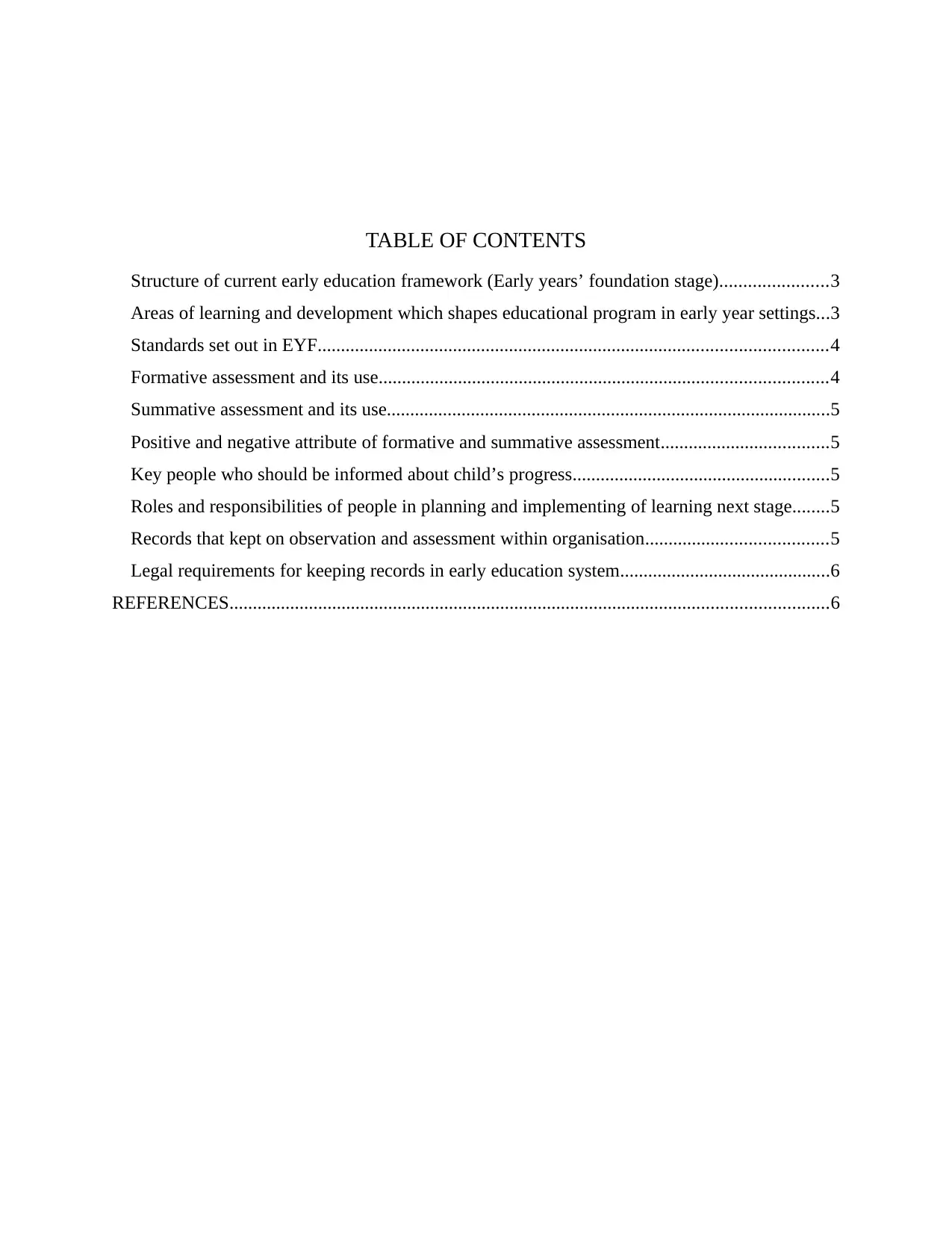
TABLE OF CONTENTS
Structure of current early education framework (Early years’ foundation stage).......................3
Areas of learning and development which shapes educational program in early year settings...3
Standards set out in EYF.............................................................................................................4
Formative assessment and its use................................................................................................4
Summative assessment and its use...............................................................................................5
Positive and negative attribute of formative and summative assessment....................................5
Key people who should be informed about child’s progress.......................................................5
Roles and responsibilities of people in planning and implementing of learning next stage........5
Records that kept on observation and assessment within organisation.......................................5
Legal requirements for keeping records in early education system.............................................6
REFERENCES................................................................................................................................6
Structure of current early education framework (Early years’ foundation stage).......................3
Areas of learning and development which shapes educational program in early year settings...3
Standards set out in EYF.............................................................................................................4
Formative assessment and its use................................................................................................4
Summative assessment and its use...............................................................................................5
Positive and negative attribute of formative and summative assessment....................................5
Key people who should be informed about child’s progress.......................................................5
Roles and responsibilities of people in planning and implementing of learning next stage........5
Records that kept on observation and assessment within organisation.......................................5
Legal requirements for keeping records in early education system.............................................6
REFERENCES................................................................................................................................6
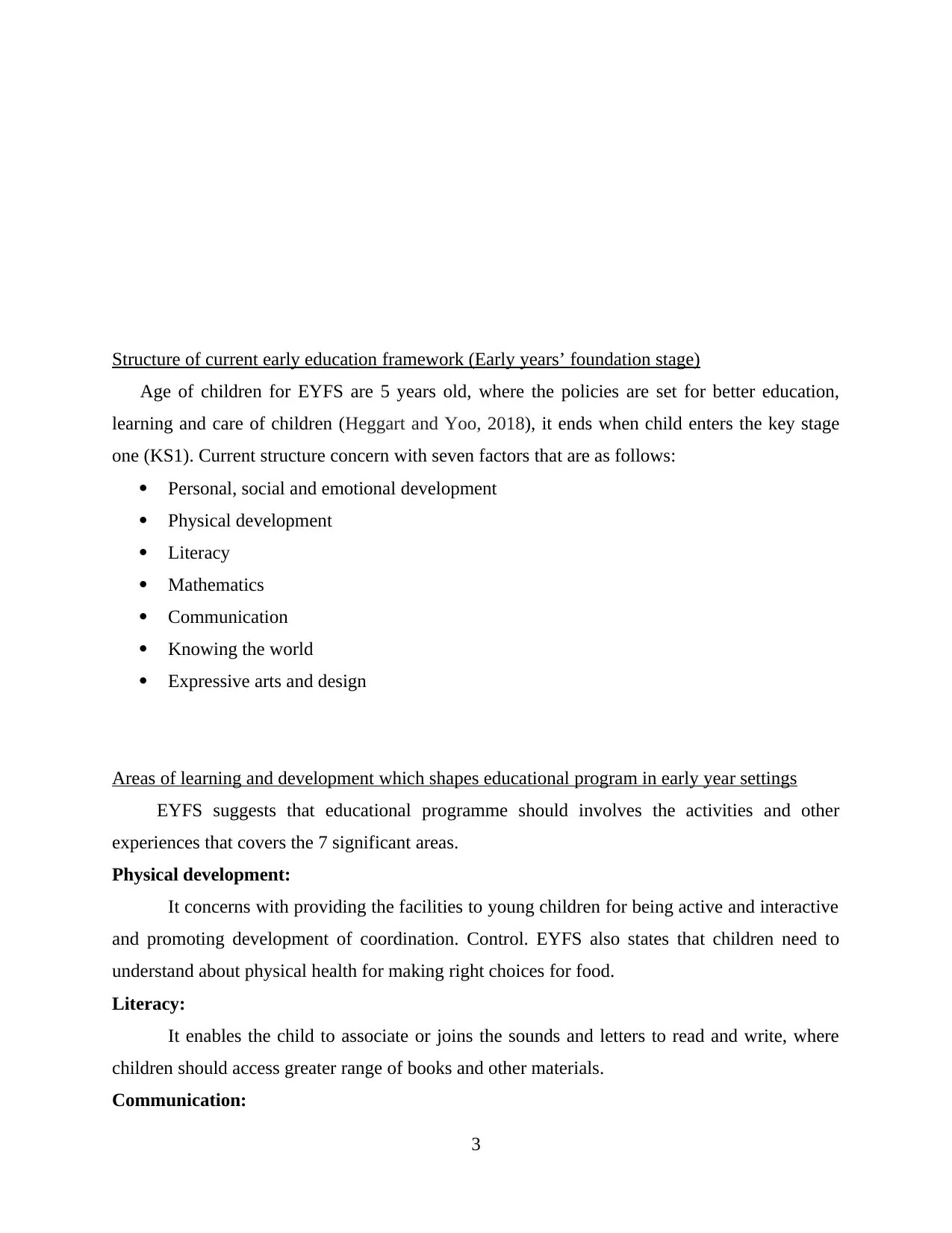
Structure of current early education framework (Early years’ foundation stage)
Age of children for EYFS are 5 years old, where the policies are set for better education,
learning and care of children (Heggart and Yoo, 2018), it ends when child enters the key stage
one (KS1). Current structure concern with seven factors that are as follows:
Personal, social and emotional development
Physical development
Literacy
Mathematics
Communication
Knowing the world
Expressive arts and design
Areas of learning and development which shapes educational program in early year settings
EYFS suggests that educational programme should involves the activities and other
experiences that covers the 7 significant areas.
Physical development:
It concerns with providing the facilities to young children for being active and interactive
and promoting development of coordination. Control. EYFS also states that children need to
understand about physical health for making right choices for food.
Literacy:
It enables the child to associate or joins the sounds and letters to read and write, where
children should access greater range of books and other materials.
Communication:
3
Age of children for EYFS are 5 years old, where the policies are set for better education,
learning and care of children (Heggart and Yoo, 2018), it ends when child enters the key stage
one (KS1). Current structure concern with seven factors that are as follows:
Personal, social and emotional development
Physical development
Literacy
Mathematics
Communication
Knowing the world
Expressive arts and design
Areas of learning and development which shapes educational program in early year settings
EYFS suggests that educational programme should involves the activities and other
experiences that covers the 7 significant areas.
Physical development:
It concerns with providing the facilities to young children for being active and interactive
and promoting development of coordination. Control. EYFS also states that children need to
understand about physical health for making right choices for food.
Literacy:
It enables the child to associate or joins the sounds and letters to read and write, where
children should access greater range of books and other materials.
Communication:
3
⊘ This is a preview!⊘
Do you want full access?
Subscribe today to unlock all pages.

Trusted by 1+ million students worldwide
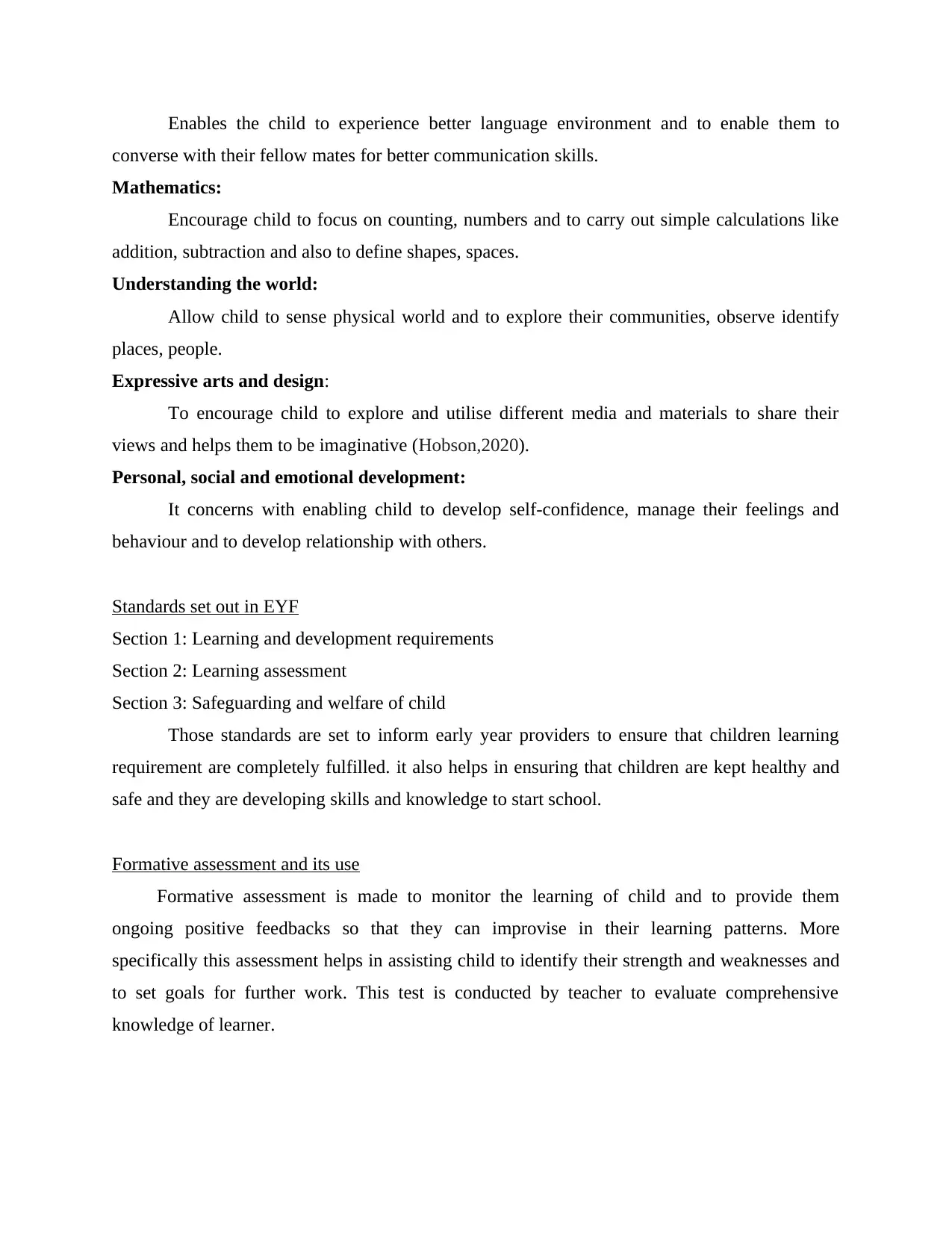
Enables the child to experience better language environment and to enable them to
converse with their fellow mates for better communication skills.
Mathematics:
Encourage child to focus on counting, numbers and to carry out simple calculations like
addition, subtraction and also to define shapes, spaces.
Understanding the world:
Allow child to sense physical world and to explore their communities, observe identify
places, people.
Expressive arts and design:
To encourage child to explore and utilise different media and materials to share their
views and helps them to be imaginative (Hobson,2020).
Personal, social and emotional development:
It concerns with enabling child to develop self-confidence, manage their feelings and
behaviour and to develop relationship with others.
Standards set out in EYF
Section 1: Learning and development requirements
Section 2: Learning assessment
Section 3: Safeguarding and welfare of child
Those standards are set to inform early year providers to ensure that children learning
requirement are completely fulfilled. it also helps in ensuring that children are kept healthy and
safe and they are developing skills and knowledge to start school.
Formative assessment and its use
Formative assessment is made to monitor the learning of child and to provide them
ongoing positive feedbacks so that they can improvise in their learning patterns. More
specifically this assessment helps in assisting child to identify their strength and weaknesses and
to set goals for further work. This test is conducted by teacher to evaluate comprehensive
knowledge of learner.
converse with their fellow mates for better communication skills.
Mathematics:
Encourage child to focus on counting, numbers and to carry out simple calculations like
addition, subtraction and also to define shapes, spaces.
Understanding the world:
Allow child to sense physical world and to explore their communities, observe identify
places, people.
Expressive arts and design:
To encourage child to explore and utilise different media and materials to share their
views and helps them to be imaginative (Hobson,2020).
Personal, social and emotional development:
It concerns with enabling child to develop self-confidence, manage their feelings and
behaviour and to develop relationship with others.
Standards set out in EYF
Section 1: Learning and development requirements
Section 2: Learning assessment
Section 3: Safeguarding and welfare of child
Those standards are set to inform early year providers to ensure that children learning
requirement are completely fulfilled. it also helps in ensuring that children are kept healthy and
safe and they are developing skills and knowledge to start school.
Formative assessment and its use
Formative assessment is made to monitor the learning of child and to provide them
ongoing positive feedbacks so that they can improvise in their learning patterns. More
specifically this assessment helps in assisting child to identify their strength and weaknesses and
to set goals for further work. This test is conducted by teacher to evaluate comprehensive
knowledge of learner.
Paraphrase This Document
Need a fresh take? Get an instant paraphrase of this document with our AI Paraphraser
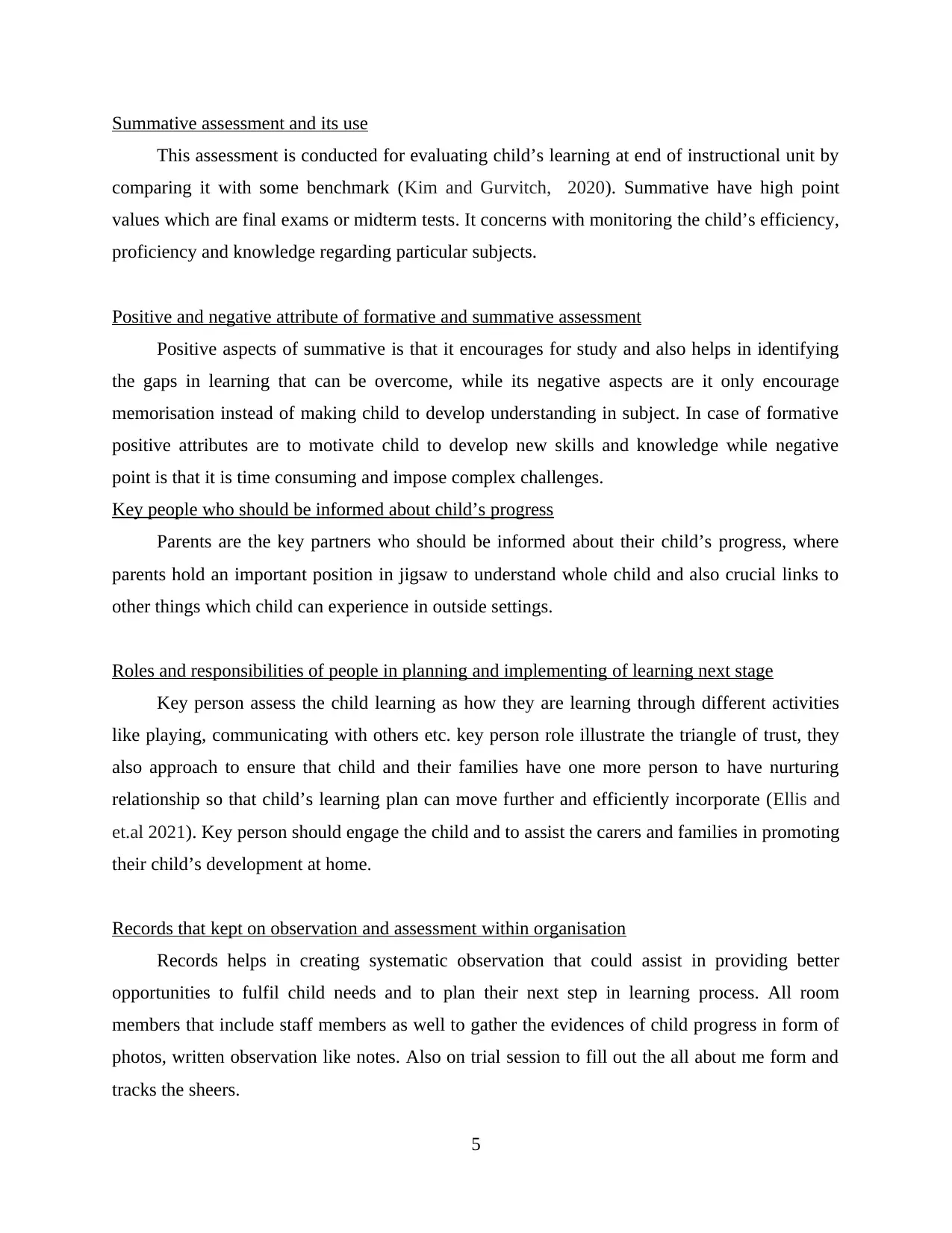
Summative assessment and its use
This assessment is conducted for evaluating child’s learning at end of instructional unit by
comparing it with some benchmark (Kim and Gurvitch, 2020). Summative have high point
values which are final exams or midterm tests. It concerns with monitoring the child’s efficiency,
proficiency and knowledge regarding particular subjects.
Positive and negative attribute of formative and summative assessment
Positive aspects of summative is that it encourages for study and also helps in identifying
the gaps in learning that can be overcome, while its negative aspects are it only encourage
memorisation instead of making child to develop understanding in subject. In case of formative
positive attributes are to motivate child to develop new skills and knowledge while negative
point is that it is time consuming and impose complex challenges.
Key people who should be informed about child’s progress
Parents are the key partners who should be informed about their child’s progress, where
parents hold an important position in jigsaw to understand whole child and also crucial links to
other things which child can experience in outside settings.
Roles and responsibilities of people in planning and implementing of learning next stage
Key person assess the child learning as how they are learning through different activities
like playing, communicating with others etc. key person role illustrate the triangle of trust, they
also approach to ensure that child and their families have one more person to have nurturing
relationship so that child’s learning plan can move further and efficiently incorporate (Ellis and
et.al 2021). Key person should engage the child and to assist the carers and families in promoting
their child’s development at home.
Records that kept on observation and assessment within organisation
Records helps in creating systematic observation that could assist in providing better
opportunities to fulfil child needs and to plan their next step in learning process. All room
members that include staff members as well to gather the evidences of child progress in form of
photos, written observation like notes. Also on trial session to fill out the all about me form and
tracks the sheers.
5
This assessment is conducted for evaluating child’s learning at end of instructional unit by
comparing it with some benchmark (Kim and Gurvitch, 2020). Summative have high point
values which are final exams or midterm tests. It concerns with monitoring the child’s efficiency,
proficiency and knowledge regarding particular subjects.
Positive and negative attribute of formative and summative assessment
Positive aspects of summative is that it encourages for study and also helps in identifying
the gaps in learning that can be overcome, while its negative aspects are it only encourage
memorisation instead of making child to develop understanding in subject. In case of formative
positive attributes are to motivate child to develop new skills and knowledge while negative
point is that it is time consuming and impose complex challenges.
Key people who should be informed about child’s progress
Parents are the key partners who should be informed about their child’s progress, where
parents hold an important position in jigsaw to understand whole child and also crucial links to
other things which child can experience in outside settings.
Roles and responsibilities of people in planning and implementing of learning next stage
Key person assess the child learning as how they are learning through different activities
like playing, communicating with others etc. key person role illustrate the triangle of trust, they
also approach to ensure that child and their families have one more person to have nurturing
relationship so that child’s learning plan can move further and efficiently incorporate (Ellis and
et.al 2021). Key person should engage the child and to assist the carers and families in promoting
their child’s development at home.
Records that kept on observation and assessment within organisation
Records helps in creating systematic observation that could assist in providing better
opportunities to fulfil child needs and to plan their next step in learning process. All room
members that include staff members as well to gather the evidences of child progress in form of
photos, written observation like notes. Also on trial session to fill out the all about me form and
tracks the sheers.
5
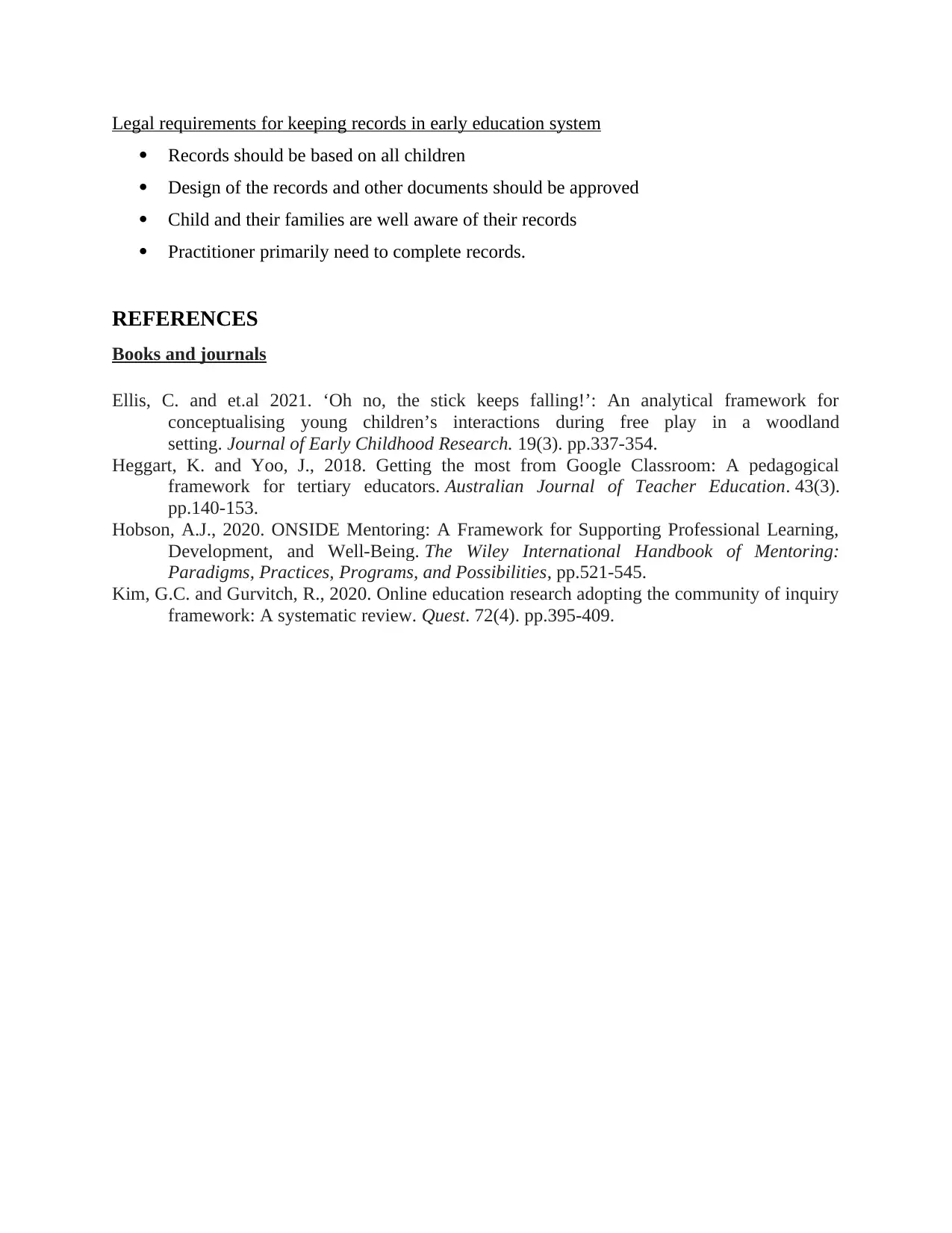
Legal requirements for keeping records in early education system
Records should be based on all children
Design of the records and other documents should be approved
Child and their families are well aware of their records
Practitioner primarily need to complete records.
REFERENCES
Books and journals
Ellis, C. and et.al 2021. ‘Oh no, the stick keeps falling!’: An analytical framework for
conceptualising young children’s interactions during free play in a woodland
setting. Journal of Early Childhood Research. 19(3). pp.337-354.
Heggart, K. and Yoo, J., 2018. Getting the most from Google Classroom: A pedagogical
framework for tertiary educators. Australian Journal of Teacher Education. 43(3).
pp.140-153.
Hobson, A.J., 2020. ONSIDE Mentoring: A Framework for Supporting Professional Learning,
Development, and Well‐Being. The Wiley International Handbook of Mentoring:
Paradigms, Practices, Programs, and Possibilities, pp.521-545.
Kim, G.C. and Gurvitch, R., 2020. Online education research adopting the community of inquiry
framework: A systematic review. Quest. 72(4). pp.395-409.
Records should be based on all children
Design of the records and other documents should be approved
Child and their families are well aware of their records
Practitioner primarily need to complete records.
REFERENCES
Books and journals
Ellis, C. and et.al 2021. ‘Oh no, the stick keeps falling!’: An analytical framework for
conceptualising young children’s interactions during free play in a woodland
setting. Journal of Early Childhood Research. 19(3). pp.337-354.
Heggart, K. and Yoo, J., 2018. Getting the most from Google Classroom: A pedagogical
framework for tertiary educators. Australian Journal of Teacher Education. 43(3).
pp.140-153.
Hobson, A.J., 2020. ONSIDE Mentoring: A Framework for Supporting Professional Learning,
Development, and Well‐Being. The Wiley International Handbook of Mentoring:
Paradigms, Practices, Programs, and Possibilities, pp.521-545.
Kim, G.C. and Gurvitch, R., 2020. Online education research adopting the community of inquiry
framework: A systematic review. Quest. 72(4). pp.395-409.
⊘ This is a preview!⊘
Do you want full access?
Subscribe today to unlock all pages.

Trusted by 1+ million students worldwide
1 out of 6
Related Documents
Your All-in-One AI-Powered Toolkit for Academic Success.
+13062052269
info@desklib.com
Available 24*7 on WhatsApp / Email
![[object Object]](/_next/static/media/star-bottom.7253800d.svg)
Unlock your academic potential
Copyright © 2020–2025 A2Z Services. All Rights Reserved. Developed and managed by ZUCOL.





